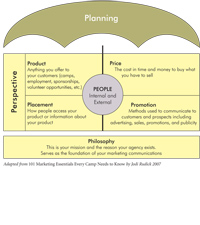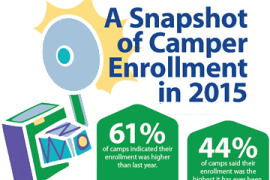If you've ever taken a high school or college marketing class, you probably learned early on about the "Four Ps of Marketing." Since the 1940s these Classic Ps (Price, Product, Placement, and Promotion) were used to steer communications activities for businesses and organizations. However, over the course of my twenty plus years working primarily with public agencies, nonprofit organizations, and small businesses, I've found that there are at least four more Ps that need to be added to this classic mix. These additional Ps include Philosophy, Perspective, Planning, and (go, figure) People.
The Eight Ps of Marketing
 As the American Camp Association (ACA) moves toward the goals of its 20/20 Vision, these Eight Ps of Marketing serve as a practical model to investigate this initiative. Over the next few issues of Camping Magazine, this column will explore the 20/20 Vision using a marketing lens focusing on each of these Eight Ps of Marketing.
As the American Camp Association (ACA) moves toward the goals of its 20/20 Vision, these Eight Ps of Marketing serve as a practical model to investigate this initiative. Over the next few issues of Camping Magazine, this column will explore the 20/20 Vision using a marketing lens focusing on each of these Eight Ps of Marketing.
1. Product
What do ACA and its members "sell"? What does the word "camp" mean or imply to today's target audience? Does the word "camp" conjure up positive or negative images for today's parents? Do we need to redefine camp to better communicate benefits to culturally diverse audiences?
2. Price
ACA-Accredited® camps price their programs across a wide spectrum ranging from free to very high end. As an overall industry, do we do a good job attracting campers from all economic backgrounds?
3. Placement
Camps can be geographically found all over the world — in urban, rural, and suburban environments — from beaches to mountain camps. Do we excel at communicating how varied the camp environment can be?
4. Promotion
Are camps using a suitable mix of publicity, promotion, and advertising based on each one's ability to efficiently reach the chosen target audiences?
5. Perspective
Do we resource other youth-serving organizations to gain their perspective — how do they define "camper?"
6. Philosophy
ACA's current mission statement is "enriching the lives of children, youth, and adults through the camp experience." How does this apply to the work we do at camp?
7. People
Internal — How are we engaging people who work in the camp profession? Could we be doing more to keep alumni staff connected to the camp brand for a lifetime?
External — While perspective campers make up the bulk of external customers, what is our definition of a camper? Have we become too youth-based in a society with more than 78 million baby boomers reaching retirement age? What are we doing to bring community members, with and without personal camp experience, into our organizations?
8. Planning
A marketing plan is not a luxury item, but rather a critical tool to guide both internal and external communications activities. How are camps using this critical tool to reach their goals?
Let's Make a Plan
Using my 8 Ps of Marketing it only makes sense to start at the top — the Marketing Plan. We need to see the world like a marketer does — as a set of objectives, strategies, and outcomes that can be achieved with a well-executed marketing plan. At its core, this plan asks.
- What are we trying to accomplish? (objectives)
- How will we get there? (strategies)
- What will success look like? (outcomes)
ACA's 20/20 Vision is no exception. ACA has outlined some exciting, yet lofty, goals in its 20/20 Vision and, when looked at through a marketing lens, these goals create a new kind of focus that will benefit every facet of the industry — from strengthening the overall worldwide "camp brand" to increasing registration at your specific camp.
However, a marketing plan itself is more than an idea. It must be a written document, similar to an architect's blueprint. This blueprint helps everyone in your organization — whether they work on the other side of the room or the other side of the globe — understand what you and your organization are trying to create. Whether you are building a state-of-the-art, multimillion-dollar facility or attempting to create a more loyal customer base — a blueprint is an essential part of the process. Without this marketing blueprint, you are likely to waste precious time, money, and energy on ineffective promotional tactics. By taking a few hours, or even minutes, to plan your promotion, you're guaranteed greater return on your overall marketing investment.
The Q and A Marketing Plan
Whether working with an organization as large as ACA or as small as an individual camp, the marketing planning process remains the same. A strong marketing foundation is constructed using a series of questions and answers that ultimately lead to marketing activities. In its simplest form, a marketing plan can be developed based on the following information:
- Product: What are you selling with this marketing plan? Are you selling camp registration, volunteerism, sponsorship, jobs? Each of these camp "products" may deserve its own plan. Rarely does a one-size-fits-all plan work well to fit any organization's needs.
- Objective: What are we trying to accomplish with this marketing plan? Marketing objectives must be realistic, measurable/quantifiable, and obtainable in a specific time frame.
- Target Audience: Who must be reached to meet the objective? There are several types of target audiences which must be included in the plan:
- End-user targets — Potential campers/volunteers/donors/staff/ sponsors/etc.
- Gate-keeper targets — Those people who, by nature of their jobs, influence, or power can open (or close) gates that lead to our target audiences and amplify wordof- mouth. (Teachers are gatekeepers to youth; doctors/therapists are gatekeepers to special needs campers, etc.).
- Internal audiences — Those who serve your end-users (counselors, registrars, front-desk staff, Web designers, etc.).
- Decision-makers — People within your organization such as board members, committee members, financial managers.
- Market Research: Four Key Areas to Explore - The Competition — Who are your competitors? Don't just think in terms of other camps. Think globally about the ways noncustomers spend time — video games, malls, family vacations, watching television, summer school, etc.
- Customer Needs Assessment — What are our customers' needs, concerns, problems, and desires?
- Market Factors — What outside factors might impact the customer?
- Trend Analysis — What trends are affecting our customers, camp, community, or industry?
- USP (Unique Selling Proposition) — This is like your DNA, your winning formula.
- What makes you the best choice for your customers and prospects?
- Knowing what you know about your competition, trends, and target audience needs, what makes you the very best choice?
- With all the other options available to this target audience, why will they choose your product (camp) to fulfill their needs or solve their problems?
- Motivating Message
- What will you say to motivate action from your target audience?
- How will you use theme, copy, and graphics to attract and hold attention?
- Media — Media refers to any and all communication channels such as publicity, advertising, on and off-line social networking, face-to-face sales presentations, promotions, trade shows, direct mail, digital media, and hundreds more. The question for you is which media will best reach your target audience?
- Budget — How much will we invest in time, talent, and money to reach the chosen target audience?
- Timeline — When will activities take place? Think in terms of before, during, and after camp activities.
While working through this simple Q and A Plan is a good first step to improving your results, marketing is also about taking action. The word "promote" literally means to "move forward." So, all the ideas, research, creative concepts, and brilliant brainstorming are worthless without putting ideas into action.
Become Part of the Vision ACA's 20/20
Vision is about the future of the camp experience and the future of your camps. Although a national initiative, to be successful, it must also become a grassroots movement. In order to increase participation, involvement, support, and public perception, ACA at the national level will certainly introduce marketing strategies, launch promotional campaigns, engage the media, and build profitable partnerships.
However, ACA can't do this alone. Aggressive goals, such as those outlined in the 20/20 Vision, will take patience, persistence, consistency, and collaboration. While ACA can lead the charge, it will take a collective of its members and leaders to carry out local activities. Individual camps, campers, parents, and alumni must also get involved — as storytellers and spokespeople. Together we can set our sights on the 20/20 Vision.
Jodi Rudick, M.A.S., is the president of ADvisors Marketing Group, a firm specializing in low-cost marketing strategies and workshops for camps, parks, and recreation agencies. Contact her at 760-809-3231 or [email protected]. Rudick's book 101 Marketing Essentials Every Camp Needs to Know is available through ACA's Bookstore or by calling 888-229-5745.
Originally published in the 2008 September/October issue of Camping Magazine.


